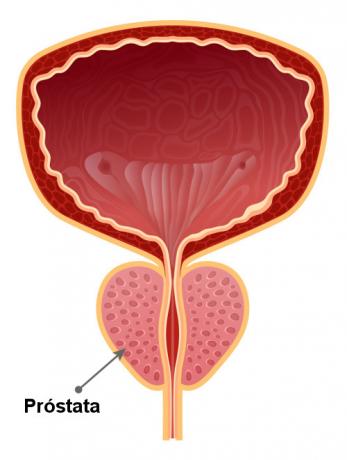With the end of October and the celebrations of the Pink October, starts the month of November, with another movement that aims to alert the population about the cancer: O Blue november. This international movement, initially celebrated in Australia since 2003, focuses on the awareness of the male public about prostate cancer, a major cause of death among men.
Next, we'll learn more about prostate cancer and this important campaign!
Read too: Is a tumor cancer? Definitions and main doubts
Blue november
November is World Prostate Cancer Month and aims to alert everyone about the importance of knowing this disease and making an early diagnosis of it.
This campaign is also aimed at break taboos, since prostate cancer is always treated with great prejudice by men, mainly due to the clinical examination (DRE). Therefore, many prefer not to look for a urologist, causing the diagnosis to be made late.
The month of November was chosen, as the 17th of November is the World Prostate Cancer Day. Throughout the month, actions are carried out with the aim of raising awareness about the disease and, just like in Outubro Rosa, several tourist spots in the country and the world are illuminated, this time in the shade of blue.
It is hoped that the annual awareness campaigns about the disease will encourage men to seek medical attention regularly and increase the population's knowledge about this disease. neoplasm.

Read too:10 leading causes of death in the world
the prostate
THE prostate is gland that is part of the male reproductive system. It is the size of a chestnut, located just below the bladder and encircling the first portion of the urethra. This gland plays an important role in reproduction, since releases a secretion that will be eliminated at the time of ejaculation and ensures the viability of sperm. This secretion has anticoagulant enzymes and also nutrients for male gametes.
The prostate can suffer a benign increaseas man ages. This increase is seen in almost all men over the age of 70 and can cause a urethral obstruction, preventing the proper passage of urine. In addition, the prostate is also a place where the development of cancer is often observed, and this disease is common in men over 65 years of age.
Do not stop now... There's more after the advertising ;)
Prostate cancer
Prostate cancer is the type of cancer that occurs most in men in all regions of our country, after skin cancer not melanoma. The incidence of prostate cancer is high, but the subject is often not treated with due attention by men. The expectation of the José Alencar Gomes da Silva National Cancer Institute (Inca) is that in 2018 alone, 68,220 new cases of the disease will have appeared in Brazil. According to the Oncoguia Institute, about 1 man in 36 will die from prostate cancer.
Prostate cancer is closely related to the patient's age. More than 70% of patients were diagnosed at age 65 or older. With these data, it is possible to see that the increased life expectancy around the world is closely related to the number of occurrences of the disease. In addition evolution of diagnostic methods can also explain that number.

In addition to age, other factors seem to be related to the onset of prostate cancer. First, we must highlight that patients who have relatives who had the disease have an increased risk of developing it. Furthermore, black men are more likely to develop the disease than white men, as well as obese are at higher risk.
Allied to these factors, we cannot fail to mention the unhealthy eating habits, a topic that is still controversial, but it deserves attention. A diet high in fat, meat and sausages can cause serious health problems, including the development of prostate cancer. Therefore, controlling the diet, always worrying about including vegetables in the diet, can help protect against this cancer and other diseases.
The diagnosis of the disease is made by analyzing the results of clinical examinations (digital rectal examination) It's from blood test termed Prostate-Specific Antigen (PSA). The rectal examination is done because the gland is located in front of the rectum and, on examination, the doctor can see its texture and assess whether there are any lumps. This exam is fast and little bother.
O PSA, in turn, is a blood test that assesses the amount of prostate specific antigen (enzyme produced by prostate tissue), which tends to increase in cases of prostate cancer. In most men, the PSA level is less than 4 ng/mL. If any changes are observed in these tests, a biopsy should be performed.
The recommendation to perform tests for the diagnosis of this type of cancer depends on the physician's assessment. It is usually recommended that they be done. from 50 years old deity. In patients who have a family history of this disease, the recommendation is that tests be performed after 45 years of age.
Treatment for prostate cancer is based on the use of techniques such as surgery and radiotherapy. Choosing the best technique will depend on factors such as tumor staging, the patient's age and other diseases that he may have.
It is noteworthy that greater chances of cure are directly related to early diagnosis. Thus, it is important to perform the exams at the indicated age and when symptoms occur, such as pains when urinating, want to urinate frequently and presence ofblood in urine or semen.
Take advantage of the campaign and find out! To learn more about the topic, read our text:Prostate cancer.
By Ma. Vanessa dos Santos

